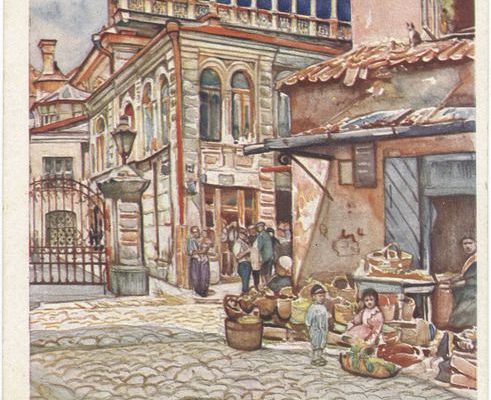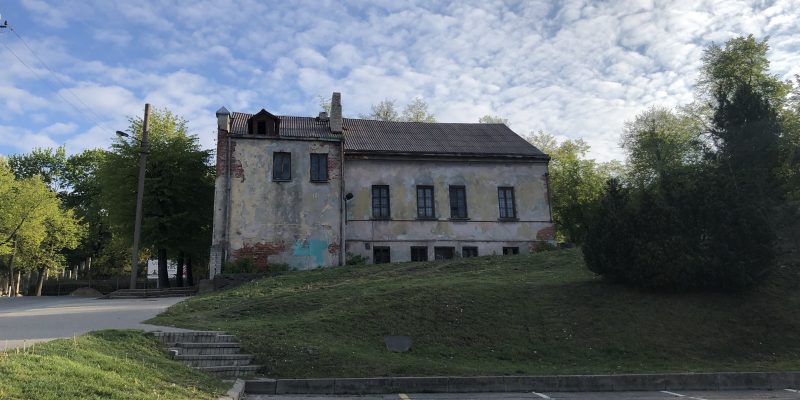WORTH VISITING:
Even though there were more than 100 Jewish prayer houses in Vilnius at the beginning of the 20th century, but only two of them were actually called synagogues. One of them was Taharat Ha-Kodesh synagogue on Pylimo street and The Great Synagogue on Žydų (Jewish) street, which was simply called “city synagogue”. All other Jewish prayer houses were usually called kloiz. The Great synagogue on the Jewish street gradually became inseparable from the image of Vilna Jews.
BRIEF HISTORY:
There is a historical guess, that in 1573 the first synagogue built in the place of Great Vilna Synagogue was a wooden building. This building had been demolished for a few times and it was built as a mural synagogue at last in 1633 when the Vilna Jewish community received such a privilege from the king Vladislav Vaza. The original mural synagogue in Renaissance style was rebuilt for several times – lastly, after the great fire of 18th century, the synagogue has been reconstructed in late Baroque style by J. K. Glaubitz. As such Baroque style synagogue, this building is remembered from its flourishing days at the beginning of the 20th century. During the years of the Second World War, the synagogue has been ravaged and during the later Soviet occupation, it has been demolished in 1953.
The Great synagogue mostly amazed by its size those visitors who would come inside the synagogue. The height of the synagogue from the outside was restricted by medieval European Christian prohibition to built synagogues higher and more splendid than Catholic churches in the city. These restrictions are also mentioned in the king`s privilege, which allowed the building of a synagogue in Vilnius. Local Jews aimed to respect this prohibition, but they also wanted to create an extraordinary prayer house for the community. So they found a clever way – the floors of this (and other) synagogue were recessed, thus creating a sense of space and majesty inside the building. The Synagogue has been adored for its exclusive interior as well.
The Great Synagogue became a significant place for Vilna Jewish community, and gradually shulhoyf – a yard next to synagogue – has formed. It meant more than religious buildings – it was a place of gathering for all community members. At the beginning of the 20th century, there were 12 prayer houses next to the to Great synagogue, communal bathhouses and mikveh, public toilets (the first ones in Vilnius!), water well, butcher houses with kosher meat, places for gatherings of Talmudic scholars and famous Judaica library of Matihaju Strašūnas. The whole life of Vilna Jews revolved around this shulhoyf for a long time, and it was the busiest and noisiest place in Vilnius city. Personal and social matters were resolved in this yard, and the news (or rumors) spread hear faster than anywhere else. This place had a special aura, which gathered religious and secular scholars, poets and painters, philosophers and chimney-sweepers.
CURRENT SITUATION:
In 2020 there is still a Soviet building of the previous kindergarten in the place where before 1952 stood the Great Synagogue. It is almost a decade now since the archeological excavations started in the previous place of the synagogue. There is a constant discussion between the local Jewish community, active society members, and heritage experts about the possibilities to commemorate this important place. Even though many ideas were already presented, but still there is no consensus on this matter.
LOOKING AROUND:
Historical Jewish quarter, 54.679532, 25.285090
Jewish street, 54.679532, 25.285090
The mausoleum of Vilna Gaon and his family (Jewish cemetery, Sudervė road, 28), 54.712898, 25.234477
A sculpture of Vilna Gaon (Žydų g. 3), 54.680137, 25.285079
Choral synagogue Taharat ha–Kodesh (Pylimo g. 39), 54.676070, 25.281575
Užupis synagogue (Užupio g. 36), 54.681471, 25.298633
A sculpture of doctor Cemachas Šabadas (sculpt. Romualdas Kvintas), 54.677248, 25.284342
Pohulanka (now. J. Basanavičius street), 54.680145, 25.276134
The place of YIVO institute and its memorial plague (Vivulskio g. 18), 54.678840, 25.265085;
The place of old Jewish cemetery in Šnipiškės (Olimpiečių g. 1a), 54.690243, 25.291117
Jewish cemetery in Užupis (Olandų g. 22), 54.688106, 25.307748
The printing house of widow Rom and Rom brothers (A. Strazdelio g. 3), 54.675534, 25.292128


